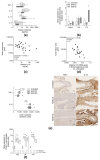Nicotinamide Prevents Apolipoprotein B-Containing Lipoprotein Oxidation, Inflammation and Atherosclerosis in Apolipoprotein E-Deficient Mice
- PMID: 33233455
- PMCID: PMC7700561
- DOI: 10.3390/antiox9111162
Nicotinamide Prevents Apolipoprotein B-Containing Lipoprotein Oxidation, Inflammation and Atherosclerosis in Apolipoprotein E-Deficient Mice
Abstract
The potential of nicotinamide (NAM) to prevent atherosclerosis has not yet been examined. This study investigated the effect of NAM supplementation on the development of atherosclerosis in a mouse model of the disease. The development of aortic atherosclerosis was significantly reduced (NAM low dose: 45%; NAM high dose: 55%) in NAM-treated, apolipoprotein (Apo)E-deficient mice challenged with a Western diet for 4 weeks. NAM administration significantly increased (1.8-fold) the plasma concentration of proatherogenic ApoB-containing lipoproteins in NAM high-dose (HD)-treated mice compared with untreated mice. However, isolated ApoB-containing lipoproteins from NAM HD mice were less prone to oxidation than those of untreated mice. This result was consistent with the decreased (1.5-fold) concentration of oxidized low-density lipoproteins in this group. Immunohistochemical staining of aortas from NAM-treated mice showed significantly increased levels of IL-10 (NAM low-dose (LD): 1.3-fold; NAM HD: 1.2-fold), concomitant with a significant decrease in the relative expression of TNFα (NAM LD: -44%; NAM HD: -57%). An improved anti-inflammatory pattern was reproduced in macrophages cultured in the presence of NAM. Thus, dietary NAM supplementation in ApoE-deficient mice prevented the development of atherosclerosis and improved protection against ApoB-containing lipoprotein oxidation and aortic inflammation.
Keywords: ATP-binding cassette (ABC) transporters; cardiovascular disease; cytokine; macrophage; niacinamide; vitamin B3.
Conflict of interest statement
The authors declare no conflict of interest.
Figures



References
Grants and funding
- PI17/00232/Instituto de Salud Carlos III/International
- PI18/00164/Instituto de Salud Carlos III/International
- 201602.31/Fundació la Marató de TV3/International
- 201605-31/Fundació la Marató de TV3/International
- CPII18/00004/Instituto de Salud Carlos III/International
- FI-DGR2014/Agència de Gestió d'Ajuts Universitaris i de Recerca/International
- BCAL04-451 - 3824321/The National Program Postgraduate Scholarships "DON CARLOS ANTONIO LOPEZ" (BECAL)/International
- PFCHA/DOCTORADO BECAS CHILE/2016-72170639/CONICYT (Comisión Nacional de Investigación Científica y Tecnología) fellowship/International
- RED2018-102799-T/Ministerio de Economía, Industria y Competitividad, Gobierno de España/International
- SAF2017-89510-R/Ministerio de Economía, Industria y Competitividad, Gobierno de España/International
LinkOut - more resources
Full Text Sources
Research Materials
Miscellaneous

